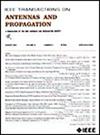基于内外表面波双工的双圆极化超表面天线
IF 4.6
1区 计算机科学
Q1 ENGINEERING, ELECTRICAL & ELECTRONIC
引用次数: 0
摘要
本文提出了一种基于双极化超表面(MTS)的天线的设计和数值验证,该天线的两种极化具有相同的圆孔径。该设计利用双向向内和向外传播的表面波(SWs)与解绕螺旋MTS阻抗模式的相互作用。两个向内/向外照明共享一个共同的辐射孔径,并由集成的三轴电缆馈电产生。向内的圆柱形波由三轴电缆(TC)的外部部分在平行板波导(PPWG)中发射,然后由孔径边缘的角反射器重定向向内。它与各向异性调制阻抗边界条件(IBC)相互作用,产生宽幅左圆极化(LHCP)光束。另一方面,向外的SW来自中心,由连接到TC内部导体的单极子激发,并提供右手圆极化(RHCP)宽侧辐射。推导了两种模式总效率的新设计公式。设计并验证了一种实用的馈电结构,具有宽带性能的共面到三轴波导转换,确保了低轮廓和简单的配置。本文章由计算机程序翻译,如有差异,请以英文原文为准。
Dual Circularly Polarized Metasurface Antenna Based on Inward and Outward Surface Wave Duplexing
This article proposes the design and numerical validation of a dual-polarized metasurface (MTS)-based antenna, in which the two polarizations share the same circular aperture. The design exploits the interaction of duplexed inward- and outward-traveling surface waves (SWs) with an unwinding spiral MTS impedance pattern. The two inward/outward illuminations share a common radiating aperture and are originated by an integrated triaxial-cable feeding. The inward cylindrical wave is launched in a parallel plate waveguide (PPWG) by the external part of the triaxial cable (TC) and then redirected inward by a corner reflector at the aperture rim. Interacting with the anisotropic-modulated impedance boundary condition (IBC), it provides a broadside left-handed circularly polarized (LHCP) beam. On the other hand, the outward SW originates from the center as excited by a monopole connected to the inner conductor of the TC and provides a right-handed circularly polarized (RHCP) broadside radiation. New design formulas are derived for the total efficiency of the two modes. A practical feeding structure is designed and validated, featuring a coplanar-to-triaxial waveguide transition for broadband performance, ensuring a low-profile and simple configuration.
求助全文
通过发布文献求助,成功后即可免费获取论文全文。
去求助
来源期刊
CiteScore
10.40
自引率
28.10%
发文量
968
审稿时长
4.7 months
期刊介绍:
IEEE Transactions on Antennas and Propagation includes theoretical and experimental advances in antennas, including design and development, and in the propagation of electromagnetic waves, including scattering, diffraction, and interaction with continuous media; and applications pertaining to antennas and propagation, such as remote sensing, applied optics, and millimeter and submillimeter wave techniques

 求助内容:
求助内容: 应助结果提醒方式:
应助结果提醒方式:


